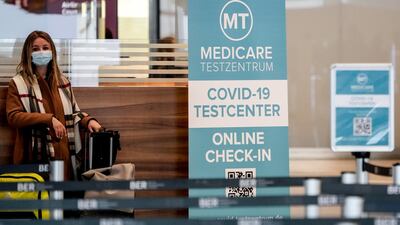International air travel is expected to remain weak in the first six months of 2021, but early signs point to a "significant surge" in demand during the second half as more people get vaccinated and cross-border travel restrictions are gradually eased, according to Airports Council International.
Despite the uptick, international passenger traffic volume will still lag behind domestic traffic in 2021. It is forecast to end the year above 1.6 billion passenger, or 4 per cent of 2019 levels, ACI, the global airports body said in its latest report on the impact of the pandemic on airports' business.
"The possibility that summer vacations abroad may happen this year is more likely than ever," ACI said.
An upsurge in confidence in air travel should see people traveling outside of their countries this spring and the number should "significantly increase by mid-year".
Domestic passenger traffic, however, is recovering faster than international traffic. It will continue to rise in 2021 to reach nearly 5 billion passengers by the end of 2021, or 65.6 per cent of pre-pandemic levels, the global airports body said.
Air transport has remained one of the hardest-hit global industries since the start of the pandemic, pushing the industry into survival mode with the loss of traffic and revenue.
The Covid-19 crisis is forecast to remove an additional 7 billion passengers by the end of 2021, representing a decline of 47.5 per cent in global passenger traffic, ACI said.
The first quarter of 2021 is expected to show little signs of improvement compared to the fourth quarter of 2020. However, "more passengers are expected to return to travel with the biggest surge in Q3 and Q4 of 2021", ACI said.
Europe and the Middle East are forecast to remain the two most impacted regions, with declines of 1 per cent and 58.9 per cent, respectively, due to their "high dependence on international travel and connectivity, which are recovering at a slower pace than domestic travel", according to the report.
Asia-Pacific will outperform all other regions in each quarter of 2021 and is forecast to end the year with an estimated traffic loss of 40.3 per cent.
Driven by the combination of a fast-recovering US domestic market and strong vaccination rate, the North America forecast for 2021 will "significantly improve" and the region is expected to end 2021 with a decline of 43.5 per cent, ACI said.
Airports, which took a massive hit in terms of revenues last year, are still reeling from the impact of the Covid-19 crisis. A decline in traffic has severely impacted their ability to collect passenger and aircraft-related fees.
"The impact of the Covid-19 crisis on airport revenues will still be deeply felt in 2021," ACI said.
Globally, airports will suffer a loss of more than $94bn of revenue by the end of 2021, according to ACI estimates.
Europe will remain the most affected region in absolute terms, with an estimated loss $4bn in revenue by year-end. In relative terms, the Middle East and Europe will take the biggest hit with a decrease of 58.9 per cent and 58.1 per cent respectively in airport revenues.
Asia-Pacific, on the other hand, will record the strongest recovery.
“The world is embarking on the biggest vaccination campaign in history, and we see positive indications in countries with high rates of vaccination,” ACI World director General Luis Felipe de Oliveira said. "An escalation of these encouraging signs and prospects for recovery with a surge in travel in the second half of 2021 is expected."
Mr de Oliveira called for "support and sensible policy decisions" from governments to ensure that aviation can fuel the global economic recovery.
“Aviation recovery will not take-off, however, without a co-ordinated and globally-consistent approach to vaccination and testing, coupled with a safe and interoperable methods of sharing testing and vaccination information," he said.




























